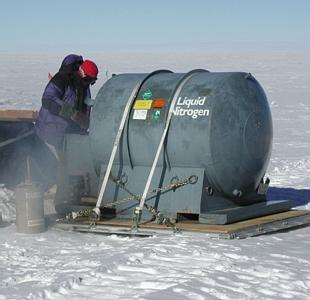20 December, 2000
Cooling a Dewar
Part of the receivers rely on superconductors. These are materials that
have no electrical resistance at very low temperatures. To keep the
receivers working, they must be kept cold, so we fill them with liquid
helium which has a temperature of 4K. (see December 7, liquid helium
fill) Today, we cooled the 230GHz receiver, which had not been used since
last summer, and thus had not been cooled since last summer.
Cooling the dewar from room temperature (nearly 300K) to liquid helium
temperature (4K) required a few steps. First, we filled the dewar with
liquid nitrogen, which has a temperature of 70K, to start it cooling. The
next step in the process is to fill it with liquid helium to cool it the
rest of the way.
Liquid nitrogen was poured into the dewar, pausing occasionally to see how
low the temperature would go. Although liquid nitrogen boils at 70K and
we could cool the dewar to that temperature, we wanted to only cool it to
90K with the liquid nitrogen to prevent any nitrogen from remaining in the
dewar. If there is nitrogen in the dewar when we fill it with helium,
then it will freeze and we will be unable to get it out without warming
the dewar up again. We donšt want to have any nitrogen ice in the dewar,
since it would remain there as long as the dewar was cold and act as an
insulator, keeping the temperature constant, above the desired 4K. This
would result in the liquid helium not lasting as long in the dewar, and
using more liquid helium than otherwise would be necessary.
Once the temperature had stabilized to 90K and we were assured that there
was no more liquid nitrogen in the dewar (since it was starting to warm
slightly), we began to fill the dewar with liquid helium. The temperature
plummeted to 4K, and then remained there as the helium began to collect
in the dewar.
To keep the dewars cold as long as possible, they have coldheads on them.
A cold head is like a small refrigerator that keeps things very cold. In
this case, it keeps the inner shielding of the dewar at 15K. This keeps
the liquid helium from boiling off as fast as it might otherwise in a
warmer environment.
Every few years, the cold heads get maintained; they are cleaned, and
parts that might wear out are replaced. This year is the year to clean
them. Today we cleaned table space and prepared to clean the coldhead on
FLaMR, the 410GHz receiver.

The liquid nitrogen used by the astronomy projects in the dark sector is kept in a large dewar outside. Here, Chris Martin is filling a 10 Liter dewar to use in AST/RO. The air temperature outside was -25 F, so some liquid nitrogen boiled off as it was transferred.
Contact the TEA in the field at
.
If you cannot connect through your browser, copy the
TEA's e-mail address in the "To:" line of
your favorite e-mail package.
|
